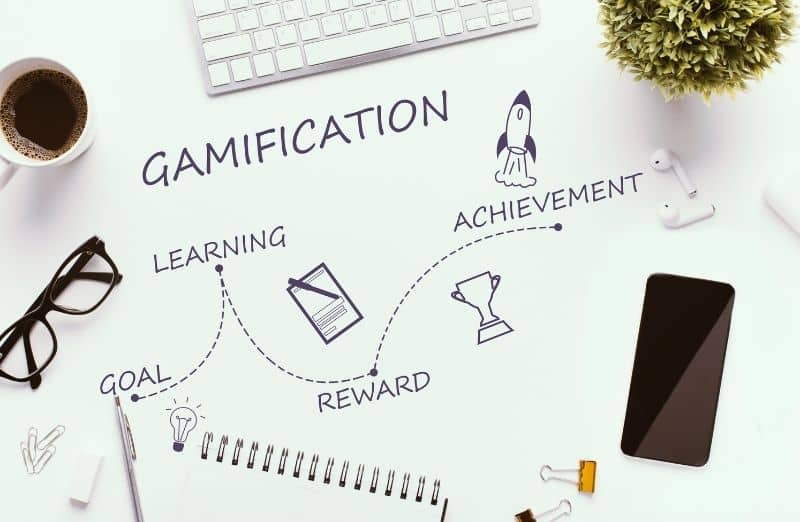Gamification is using techniques from real-life games to engage users and make a product or service more addictive.
Many senior executives use gamification in nongaming contexts because most existing products are boring, and clients are losing interest too soon. But, people can spend hours playing addictive video games and spend precious resources, money, and time.
Gamification takes game elements, like points, badges, and achievements, to reward loyal customers, train recruits, and amplify the working experience. Big corporations, educational institutions, and universities use it to engage more profits and learn skills and management.

But gamification wouldn’t be what it is today without years of evolution. The reason why gamification history is so important is that early success can help define its future. You can see how the early stages of gamification took shape and influenced users.
Here, you can learn more about its brief history, such as when gamification started, when the term was first invented, and some of the first examples of gamification.
What is the history of gamification?
Gamification is a relatively new concept, yet its roots stretch back much further than many realize. It gained widespread usage in the 21st century as a powerful engagement tool, revolutionizing how businesses, educational institutions, and various industries interact with their audiences. However, the essence of gamification has been around for quite some time, evolving through history and adapting to technological advancements.
The fact is: you don’t need mobile phones or computers to gamify a process. Many gamification initiatives use a basic mechanic to boost engagement and user enjoyment. Anything can be gamified if it incorporates game mechanics, such as:
- Rewards
- Challenge
- Motivation
- Achievement
- Story
- Punishment

The “gamification” process applies these tools to something else. It is a complex system of rewards and incentives designed to keep people engaged as much as possible. The idea is to encourage people to undertake activities that are beneficial, often resulting in a financial or personal gain.
For example, creating a points system, user ranking, leaderboards, and a way to earn badges can transform mundane tasks into engaging experiences. The gamification efforts work when you make the mechanics more game-like. This is why we can see “gamification” even back in the 1900s.
In 1908, boy scouts awarded members with badges to emphasize their achievements. Whenever boy scouts acted based on the principles of the organization or attended special events, they would get rewarded. This early form of gamification used game elements to motivate young participants, laying the groundwork for future gamification strategies.
But it wasn’t until online gaming gained momentum that we started seeing the evolution of gamification. As technology improved, gamification was slowly gaining recognition as a powerful tool for enhancing any business strategy. The rise of computer games and online gaming platforms provided a fertile ground for gamification elements to flourish, introducing mechanics that could be applied beyond gaming.
As we moved into the digital age, the integration of gamification into various sectors became more pronounced. Educational research highlighted its potential in motivating students and improving academic performance. Businesses began to recognize its value in employee engagement and customer loyalty programs. Gamification platforms emerged, offering tools to incorporate game mechanics into diverse applications, from mobile apps to enterprise software.
The history of gamification is a testament to its versatility and enduring appeal. From the early days of the boy scout movement to the sophisticated gamification software we see today, it continues to evolve, driven by technological advancements and a deeper understanding of human motivation. As gamification becomes an integral part of modern life, its ability to engage users and drive meaningful outcomes remains as relevant as ever.
Gamification timeline
The history of gamification is rich and varied, showcasing how the concept has evolved over the years to become an integral part of modern engagement strategies. To understand when gamification started, let’s delve deeper into the timeline below, which offers a comprehensive perspective on its development and the milestones that have shaped its journey.
S&H Green Stamps (1896)
One of the earliest examples of gamification in action, S&H Green Stamps were distributed as part of a rewards program designed to encourage customer loyalty. Shoppers collected stamps and redeemed them for products, introducing a game-like experience to the shopping process and laying the groundwork for future customer engagement strategies. This approach demonstrated early on how gamification could be used to incentivize behavior and build long-term customer relationships.
The Boy Scout Movement (1908)
A pivotal moment in gamification history, the Boy Scouts introduced a system where members faced a series of challenges and obstacles to earn badges. This initiative recognized achievements, ongoing commitment, and involvement, using game elements to motivate young participants and foster a sense of accomplishment. The badges served as tangible rewards for their efforts, encouraging scouts to engage more deeply with the organization’s values and activities.
The Birth of Social Video Games (1970s)
The 1970s saw the advent of social video games with companies like Sega and Atari introducing arcade games. These games were not only about entertainment but also about social interaction, as people flocked to arcade centers, gas stations, and restaurants to play and compete for high scores. This era marked a significant evolution in the use of game mechanics for engagement, as it highlighted the potential of games to bring people together and create shared experiences.
The Game of Work (1973)
Charles Coonradt’s book, “The Game of Work,” highlighted how incorporating fun and games could tackle the problem of reduced employee engagement. Coonradt observed declining productivity in recreation and sports equipment sales and suggested that game mechanics could enhance satisfaction, motivation, and productivity in the workplace. His insights laid the foundation for using gamification to improve employee engagement and performance.
Multi-User Dungeon Game (1979)
Gamification took a creative turn with the introduction of the Multi-User Dungeon (MUD) game, which combined programming, role-playing, and interactive fiction to inspire users to keep playing. Despite its text-based interface being unappealing by today’s standards, it sparked significant interest in online social gaming and demonstrated the potential of gamification in digital environments. MUDs paved the way for future developments in online gaming and virtual worlds.
What Makes Things Fun to Learn (1981)
Thomas W. Malone’s study at the Massachusetts Institute of Technology was a groundbreaking moment in gamification research. He explored intrinsically motivating computer games and outlined how gaming mechanics could be applied to various areas, particularly education, to stimulate engagement and learning. Malone’s work provided a theoretical framework for understanding how game elements can be used to motivate students and improve educational outcomes.
AAdvantage (1981)
American Airlines launched the first frequent flier program, AAdvantage, which became a critical factor in promoting customer loyalty. This program used gamification principles, such as rewards and incentives, to encourage repeat business and customer engagement. By offering points and rewards for flights, AAdvantage set a precedent for loyalty programs across industries.
Gaming Trends Spread to Millions (1990s)
The 1990s witnessed a surge in gaming popularity, with approximately 30% of American households owning a Nintendo home console. Games began awarding users with points, badges, and achievements, further embedding gamification elements into mainstream culture and setting the stage for future developments. The widespread adoption of gaming consoles demonstrated the appeal of gamification elements in everyday entertainment.
Who Plays MUAs (Multi-User Adventures) Paper (1996)
Richard Bartle’s paper provided insights into why different people play games, categorizing players into achievers, explorers, socializers, and killers. These categories helped game designers understand how different game experiences affect audiences and informed the development of modern gamification platforms. Bartle’s player types continue to influence game design and gamification strategies today.
Serious Games Initiative (SGI) (2002)
The Woodrow Wilson International Center for Scholars founded the Serious Games Initiative to leverage games for user engagement. The term “Serious Games” was preferred for educational products, emphasizing the impact of games in learning simulations, digital game-based learning, and alternative purpose games. SGI highlighted the potential of games to serve educational and social purposes beyond entertainment.
As we trace the timeline of gamification, it becomes evident that its evolution has been driven by a desire to enhance engagement, motivation, and learning across various contexts. From the early days of reward programs and scouting badges to the sophisticated gamification platforms we see today, the journey of gamification is a testament to its enduring appeal and versatility in driving meaningful outcomes. The timeline illustrates how gamification has transformed from simple reward systems to complex strategies that leverage technology and human psychology to achieve engagement and motivation in diverse fields.
When was the term gamification invented?
Wondering who coined gamification? Nick Pelling coined the term “gamification” in 2002. But, in the second half of 2010, the term saw widespread adoption. Nick Pelling is a game designer tasked with creating a game like a user interface for vending machines and ATMs.
This British-born inventor and programmer are best known as the creator of the 1984 game Frak. Pelling saw the potential and practicality of in-game mechanics as tools for industry and business. So, he decided to implement his knowledge of games elsewhere.
As games became increasingly popular, articles started to emerge, outlining the countless uses of gamification. The gamification history helped this concept become a catalyst – a powerful marketing and social tool that can be used in the workplace.
From an employer’s standpoint, it can motivate and engage employees. It can be used for designing enjoyable user interfaces, boosting enthusiasm, and creating excitement.
Gamification has also been recognized for its potential in education, healthcare, and customer engagement. In education, gamification techniques have been used to motivate students and enhance learning experiences. By incorporating game mechanics into educational platforms, educators can foster student engagement and improve academic performance. In healthcare, gamification strategies are employed to encourage healthy behaviors and adherence to treatment plans, transforming routine tasks into engaging activities that patients are more likely to follow.
Furthermore, businesses have embraced gamification to encourage customer loyalty and enhance user engagement. By adding gamification elements to their products and services, companies create more interactive and rewarding experiences for their customers. This approach not only attracts new customers but also retains existing ones, fostering long-term relationships and increasing brand loyalty.
How Gamification Transforms Engagement Across Sectors
Gamification is about more than just adding fun to a task; it involves strategically applying game design elements to create an engaging and motivating experience. By incorporating these game mechanics, organizations can transform routine activities into exciting challenges that encourage participation and drive desired behaviors. For instance, rewards can provide tangible incentives for reaching milestones, while challenges can push individuals to improve their skills and performance. Motivation plays a crucial role in keeping participants engaged, as it taps into their intrinsic desires to achieve and succeed. Storytelling can add a narrative layer that makes the experience more immersive, while punishment can be used to discourage undesirable actions.
Gamification in Business: Enhancing Engagement and Loyalty
In the business world, gamification strategies have become indispensable tools for enhancing employee engagement and fostering customer loyalty. By integrating gamification elements such as leaderboards, badges, and point systems into their products and services, companies create more interactive and rewarding experiences for their customers. This approach not only attracts new customers but also retains existing ones, fostering long-term relationships and increasing brand loyalty.
Gamification initiatives in businesses are designed to motivate employees by making tasks more enjoyable and challenging. This can lead to improved employee performance and satisfaction, as individuals feel more engaged and driven to achieve their goals. By incorporating game mechanics into training programs and everyday work activities, organizations can create a dynamic and motivating environment that encourages continuous learning and development.
Moreover, gamification techniques are employed to enhance customer engagement by transforming the user experience into an interactive journey. Companies can encourage customer loyalty by offering rewards for reaching milestones, participating in challenges, or completing specific actions. This not only boosts customer satisfaction but also strengthens brand affinity, as customers feel more connected to the brand through these engaging experiences.
As businesses continue to explore the potential of gamification, its applications are expanding across various sectors, from retail to finance to healthcare. The versatility and effectiveness of gamification make it a powerful strategy for driving meaningful outcomes and achieving business objectives. As technology advances, the integration of gamification into business strategies is expected to grow, offering new opportunities for engagement and innovation.
Gamification in education
It is hard to pinpoint who invented gamification in education. But, many believe that gamification was first used to educate young children in the scout movement in the 1900s. This youth movement aimed to shape children and cultivate character with active educational methods.
Although scouting was mainly used to train boys, it quickly became popular among young girls. In 1910, feminine units were formed, often including domestic education programs.
Over time, gamification in education has evolved significantly, with the rise of digital tools and online learning platforms. These platforms leverage game design elements such as point systems, leaderboards, and rewards to create immersive and engaging learning experiences. By making education more interactive and enjoyable, gamification helps motivate students and improve their academic performance. This approach has been particularly effective in language learning, where gamified apps and platforms encourage learners to practice regularly and achieve milestones.

As the gamification landscape continues to evolve, its applications in various sectors are expanding, driven by advancements in technology and a deeper understanding of human motivation. From the early days of scouting to the sophisticated gamification platforms we see today, the journey of gamification is a testament to its enduring appeal and versatility in driving meaningful outcomes across diverse contexts.
Gamification techniques have been employed to motivate students and enhance learning experiences. By integrating game elements such as point systems, leaderboards, and badges into educational platforms, educators can create a dynamic environment that fosters student engagement and improves academic performance. This approach has proven effective in language learning, where gamified apps and platforms encourage learners to practice regularly and achieve milestones.
Gamification’s Expanding Influence
As technology continues to evolve, the potential applications of gamification are expanding far beyond its traditional boundaries. From healthcare to fitness apps, gamification is being utilized to encourage healthy behaviors and adherence to treatment plans. This innovative approach transforms routine tasks into engaging activities, making them more appealing and easier for individuals to follow. By incorporating game mechanics such as rewards, challenges, and progress tracking, gamification motivates users to stay committed to their health goals, whether it’s taking medication regularly or maintaining a fitness routine.
In the healthcare sector, gamification techniques are employed to enhance patient engagement and improve health outcomes. By turning health-related tasks into interactive experiences, patients are more likely to adhere to treatment plans and make healthier lifestyle choices. Fitness apps, for instance, use gamification elements like leaderboards, badges, and virtual rewards to incentivize users to reach their fitness milestones and maintain an active lifestyle.
The versatility and enduring appeal of gamification make it a powerful tool for driving meaningful outcomes across various sectors. Its impact is only expected to grow as we continue to explore new ways to engage and motivate users. As gamification becomes increasingly integrated into different industries, it holds the potential to revolutionize how we approach challenges and achieve our goals, making everyday tasks more enjoyable and rewarding.
When was the first modern gamification platform created?
The evolution of gamification into a structured, modern platform began in 2005 with the creation of Bunchball by Rajat Paharia. Bunchball is recognized as the pioneering cloud-based gamification platform that enabled organizations and businesses to fully harness the power of gamification. By integrating game mechanics such as leaderboards, badges, points, and missions into the work environment, Bunchball revolutionized how companies approached employee engagement and motivation. This platform laid the groundwork for countless gamification initiatives that followed, demonstrating the potential of gamification to transform traditional business practices.
Bunchball’s innovative approach allowed companies to leverage game design elements to boost employee performance, enhance user engagement, and encourage customer loyalty. The platform’s success highlighted the effectiveness of gamification in non-game contexts, inspiring other industries to explore similar strategies.

In 2007, gamification extended beyond the corporate world and into the home environment. Kevan Davis developed a web app called Chore Wars, which gamified daily household chores. By using a collaborative RPG-style system, Chore Wars allowed users to embark on quests to maintain their homes, such as defeating the fictional Sink Rat lurking in the sink. This creative application of gamification elements showcased its versatility and ability to engage users in everyday tasks, further popularizing the concept.
The emergence of platforms like Bunchball and Chore Wars marked a significant turning point in the history of gamification. They demonstrated that game mechanics could be effectively applied to various aspects of life, from enhancing business strategies to making mundane chores more engaging. As the gamification landscape continued to evolve, these early platforms paved the way for the development of more sophisticated gamification software and tools that we see today, driving innovation and engagement across multiple sectors.
When was the first gamification summit held?
The first-ever gamification summit was held in San Francisco in 2011, marking a pivotal moment in the history of gamification. This event brought together experts, enthusiasts, and industry leaders from around the globe to explore the burgeoning potential of gamification as a transformative force across various sectors. The summit served as a platform for sharing insights, strategies, and innovations in the field, highlighting how gamification could revolutionize engagement and motivation in both personal and professional contexts.
At the summit, M2 Research CEO Wanda Meloni presented the first comprehensive analysis of the Gamification Market, unveiling its potential to become a billion-dollar industry. This analysis underscored the rapid growth and widespread adoption of gamification techniques, as businesses and organizations recognized their effectiveness in enhancing user engagement and driving desired behaviors.
The San Francisco summit attracted thousands of attendees, fostering a vibrant exchange of ideas and experiences. It provided a unique opportunity for participants to network, collaborate, and learn from one another, further fueling the momentum of the gamification movement. The event showcased the diverse applications of gamification, from improving employee performance and customer loyalty to transforming education and healthcare.
The success of the first gamification summit set the stage for future gatherings and conferences dedicated to exploring the evolving landscape of gamification. It demonstrated the increasing recognition of gamification as a powerful tool for innovation and growth, paving the way for new developments and breakthroughs in the field. As the gamification industry continues to expand, summits like these play a crucial role in shaping its trajectory and unlocking its full potential.
The lowdown
Gamification is now a common feature of software design. It is used in many commercial electronic devices as an excellent engagement tool. Many other senior executives are already considering making gamification an essential requirement in their workplace.
But, for gamification to be such a popular feature of software design, it had to start from somewhere. The gamification history spans years. Nick Pelling was the one who started gamification and coined the term back in 2002. But gamification was used long before that.

Some of the first records of gamification were seen in 1896 with the S&H Green Stamps. Followed by the boy scouting movement in 1908. As time passed, experts noticed great potential in in-game mechanics and a game-based learning environment.
Eventually, gamification gained massive attention in a more specific sense, referring to the usage of rewards or social elements of games in software
Spinify can help!
Some people believe that gamification is ahead of its time. But gamification and a game-based learning environment are here to stay.
When you look at the brief history of this concept, you can see that gamification is bound to evolve. It is versatile, practical, and creative for engaging and motivating users. If you are looking to gamify your workspace, Spinify can help.
We can implement a competition and incentive approach that blends perfectly with motivation psychology and gamification. You can use this tool in your existing platform to help your team succeed and grow.
We have valuable insight into the gamification industry. We can help you reach your targets through meaningful engagement strategies and different concepts. today and see how Spinify can help skyrocket your team’s performance. Visit our Linkedin page to learn more.




